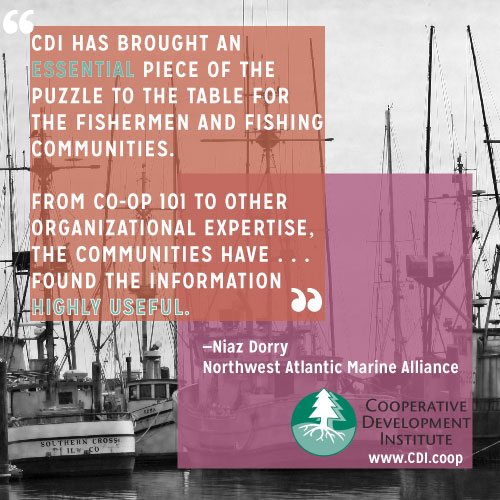
NH fishermen experienced a 78% cut in the groundfish quota allowed in 2013, along with low lobster prices and increasing costs of fuel and bait. At the same time, 98% of the groundfish landed in NH normally leaves the state with most being sold for low prices at commercial fish auctions. These factors put the New Hampshire fishing industry in a precarious position with its survival threatened. Josh Wiersma, Northeast Fishery Sector XI and XII Manager and Fishues (rhymes with “issues”) blogger Sarah VanHorn, decided that the time was right to form a Community Supported Fishery (CSF) that would help local fishermen diversify markets, meet the need of consumers for fresh, locally harvested seafood, and capitalize on an established infrastructure of fishermen, producers and processors.
“The maritime fishing industry, a vital element of the economy, culture and history of the New Hampshire Seacoast, is in crisis,” Van Horn said. “We are addressing this crisis by increasing the recognition and appreciation of the interdependent roles that the fishing industry and the consumer play in our local ecological economy.”
Taking a cue from local community supported agriculture (CSA) programs where farmers offer consumers shares of the harvest for a pre-season, pre-paid price, Wiersma and Van Horn worked with local fishermen to develop a business plan for a community supported fishery (CSF). Fourteen fishermen and crew from Seabrook, Hampton, Rye and Portsmouth—representing just about all the active boats in NH—decided to organize the initiative as a cooperative that would reconnect local consumers with commercial fishermen, and that meant bringing consumers in to the business.
Unlike traditional CSFs, New Hampshire Community Seafood is a “multi-stakeholder” cooperative, where instead of the fishermen being the sole member-owners, consumers are also offered an opportunity to become members. “This way,” Wiersma states, “interested and engaged consumers can be more directly integrated” into the CSF and its mission.
Consumers are offered the opportunity to buy a share in the cooperative in addition to their seafood share. Consumers who buy a share of NH Community Seafood are represented by a seat on the board of directors and are entitled to receive a portion of any profits made at the end of the year. Buying a share of the organization gives the consumer a voice in the organization and both the fishermen and the consumers have a vested interest in seeing the organization succeed.
NH Community Seafood consumers pre-pay for an eight-week “season” of fresh seafood consisting of half or full allotments of a weekly filleted groundfish share, a weekly whole groundfish share, or a bi-weekly underdog fish share (featuring underutilized species).
There are four “seasons” planned, with a possible fifth season in February and March featuring shrimp and scallop. Deliveries of freshly caught fish are made weekly or every other week to farmers’ markets and other community locations. Cod, redfish, cusk, king whiting, monkfish, pollack, squid, and lobster have been among the offerings. Tweets keep consumers up to speed.
Taking cooperation a step further, NH Community Seafood developed partnerships to support aggregation, processing and distribution with two businesses that are key to NH’s commercial fishery infrastructure: Yankee Fishermen’s Cooperative in Seabrook picks up the fish at the dock, sorts and grades it, and sends the highest quality fish to Seaport Fish, a family-owned wholesale and retail market in Rye, which processes and packages the fish for delivery the following day. This means consumers receive fish within 30 hours of its being landed.
Seabrook picks up the fish at the dock, sorts and grades it, and sends the highest quality fish to Seaport Fish, a family-owned wholesale and retail market in Rye, which processes and packages the fish for delivery the following day. This means consumers receive fish within 30 hours of its being landed.
As stated in its mission, NH Community Seafood aims to “provide local fishermen a fair market for all the species they catch and to provide the consumer with access to a wide variety of fresh, locally-caught seafood throughout the year, better insight into the supply chain that brings seacoast seafood to their table, and direct input about the choice and diversity of fish they consume. The cultivation and nurturing of this direct relationship between local fishermen with local consumers is intended to increase demand for local seafood, to promote community awareness and engagement in marine resource issues, and to support our local and regional economies through the preservation of the livelihoods of local fishermen and the supporting of shore-side support infrastructure.”
